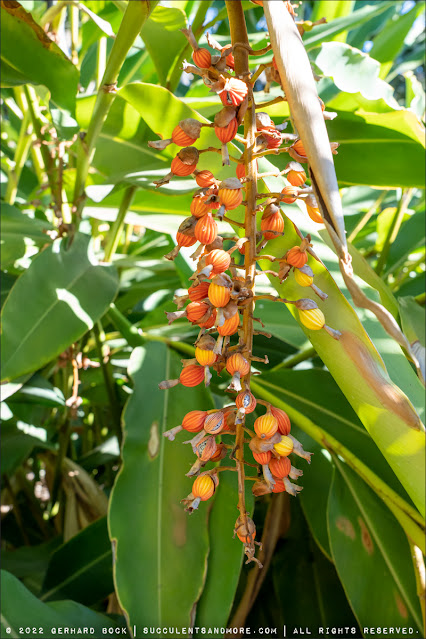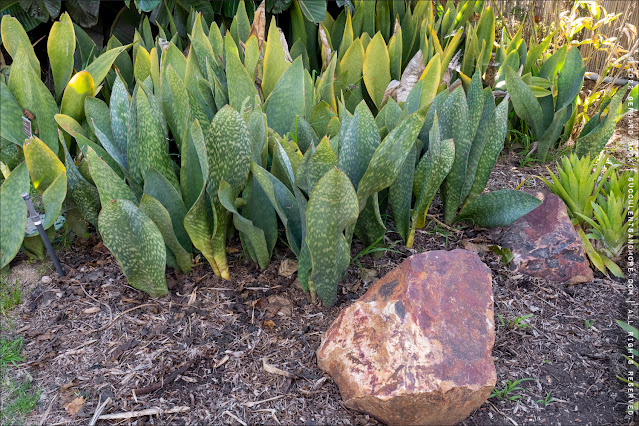Last month I had the opportunity to return to San Diego Botanic Garden (SDBG). I’d been there once before, in March 2015, but a lot has changed in the intervening seven years.
Until 2009, San Diego Botanic Garden was known as Quail Botanical Gardens, and many people still use the old name. It’s located on the former estate of Ruth and Charles Larabee, both heirs to considerable fortunes. Ruth donated the land to San Diego in 1957, paving the way for the creation of the garden we know today. Until 1993 the garden was supported by San Diego County; since then it has been privately managed by a non-profit foundation.
Named one of the “Top 10 North American Gardens Worth Traveling For” by the American Gardens Association, the SDBG encompasses 29 “uniquely themed gardens” which visitors can explore on four miles of trails. Two children’s gardens and the new Dickinson Family Education Conservatory round out the offerings.
Located right next to the entrance, the Conservancy is a beautiful space full of exotic plants—nearly 5,000 species according to the website. Six floating “plant islands” hang from the ceiling. It’s very cool, and I would have liked to spend more time there, but there were too many people in what is a partially enclosed space for me to feel completely comfortable. Maybe on my next trip, after Covid has become a thing of the past.
Instead I went out into the garden, letting myself be guided by whatever caught my eye. It’s not a systematic approach to exploring a botanical garden, but it’s the most enjoyable way. After all, I wasn’t there to do research for a scholarly paper.
Literally the first thing that stopped me in my tracks was this Agave ‘Blue Flame’, its flower stalk leaning over so much that it touched the ground. One of the parents of ‘Blue Flame’, Agave attenuata, is commonly referred to as “foxtail agave” because its inflorescence has a similar appearance:
Across the way, an Agave shawii, the other parent of ‘Blue Flame’, was in full flower, its massive inflorescence reaching into the sky:
Not far away, I captured two of the three agave species native to California in one photo, Agave shawii (green) and Agave deserti (silver-blue). Agave utahensis var. eborispina would have made the native trio complete, but it doesn’t thrive near the coast.
Another succulent native to California, Dudleya pulverulenta:
The next photo is actually pretty extraordinary. It shows a whole grove of giant coreopsis (now Leptosyne gigantea, formerly Coreopsis gigantea), native to Central and Southern California coastal areas. Giant coreopsis can be as tall as 6 feet!
In the South African Garden, many aloes were done blooming, but I found a few that were still going strong:
 |
| Orange-flowered Aloe excelsa times 2 |
 |
| Aloe chabaudii |
 |
| Aloe marlothii |
More vignettes from the South African Garden:
 |
| Dioon mejiae, a cycad native to Central America, but growing in the South African Garden next to similar-looking Encephalartos |
 |
| South African daisy (Arctotis sp. or hybrid) |
 |
| Aloes and yellow-flowering ice plant |
 |
| Crassula multicava (left) and Asparagus densiflorus ‘Myersii’ |
I didn’t take any photos in the Tropical & Temperate Rainforest—or rather, I deleted them all—because the contrast between light and dark was simply too extreme. But here are some “exotic” plants growing nearby:
 |
| Shell ginger (Alpinia zerumbet) |
 |
| Bird’s nest fern (Asplenium nidus) |
 |
| Cup vine (Solandra maxima) |
 |
| Cup vine (Solandra maxima) |
 |
| Encephalartos horridus |
 |
| Staghorn fern (Platycerium sp.) attached to a Mysore fig (Ficus mysorensis) |
The best known feature of the Mexican Garden are the life-sized succulent figures. They were created by topiary artist Pat Hammer for the 2003 Philadelphia Flower Show and originally covered with ivy. When Pat joined what was then Quail Botanical Gardens as Director of Operations in 2005 (she’s retired now), she brought them with her. Over time, volunteers replanted the figures with succulent cuttings. I wonder how often the cuttings are watered and/or replaced?
A few photos from the Walled Garden:
 |
| I’m kinda obsessed with this arrangement... |
 |
| Weeping bottle brush (Callistemon viminalis) and philodendron (possibly Philodendron ‘Xanadu’) |
 |
| Two “foxtail” inflorescences from variegated Agave attenuata |
 |
| Trunked Agave attenuata ‘Variegata’ |
 |
| Oh to be able to grow Sansevieria in the ground... |
Based on my interests, the New World Desert Garden should have been my favorite section of the SDBG. However, that wasn’t the case. The plants looked a bit neglected and area was in need of general maintenance. Still, a few things caught my eye, especially the hechtias in the first two photos:
 |
| Hechtia texensis (tentative ID) |
 |
| Hechtia roseana (tentative ID) |
 |
| Catalina silverlace (now Constancea nevinii, formerly Eriophyllum nevinii), a silver-leaved aster relative from the Channel Islands |
 |
| Impressive tangle of Puya laxa, a terrestrial bromeliad from Bolivia |
 |
| Yucca sp. |
 |
| And another Yucca sp. with curly leaf threads |
 |
| More variegated Agave attenuata |
The last set of photos are of Canary Island dragon trees (
Dracaena draco). The first three shots were taken in the Canary Island Garden, the final two in the Old World Desert Garden. As the common name suggests,
Dracaena draco is native to the Canary Islands but is also found on other islands off the west coast of Africa (i.e. the volcanic archipelagos known as
Macaronesia) as well as in southwestern Morocco. It can grow to 50 ft. and has a life span of over 1,000 (!) years. To top it off, it’s a stunningly beautiful tree. Can you imagine having a specimen like this in your garden?
Unfortunately,
Dracaena draco is not super hardy.
San Marcos Growers rates it at 20–25°F, i.e. zone 9. I’ve never seen one planted in the ground in the Sacramento area, although Lowe’s and Home Depot regularly stock it. I brought home a small plant in a 1-gallon pot from San Diego so I have my own specimen to experiment with.
The San Diego Botanic Garden is open Wednesday-Monday from 9:00 am to 5:00 pm; it’s closed on Tuesday. The main parking lot is located at the corner of Quail Gardens Drive and Ecke Ranch Road across from the San Dieguito Heritage Museum at Heritage Ranch. Entering 400 Quail Gardens Drive as the street address in your GPS will get you there.
RELATED POSTS:
© Gerhard Bock, 2022. All rights reserved. To receive all new posts by email, please subscribe here.










































The "Sansevieria in the ground" could be Sansevieria masoniana (S. whale fin): an amazing specimen which I'd love to add to my collection, although it is quite large and pricey.
ReplyDeleteI absolutely love the succulent topiary. It's so imaginative and provide an abundance of color and texture, so much better than the ivy standard.
When agave inflorescences curves down and touch the ground, to they deposit new growing pups in the soil?
This particular agave doesn't form bulbils that would drop off the inflorescence. There's no benefit for it to touch the ground, it's simply gravity.
DeleteAs I remember from a few visits, they grow their xeric plants extremely "hard"--without any irrigation, making the plants look terrible most of the time--during the long drought it was painful to see the condition some of the plants were in. Honestly, could not enjoy seeing that. The more tropical areas of the garden looked much better--and must be irrigated. Head-scratching.
ReplyDeleteDisturbing that a couple of the Dracenas are falling over.
If they really don't irrigate xeric plants, that would be a complete head scratcher to me, esp. since they must use a ton of water in the rainforest section. Aren't the plants supposed to look their best, to awe and inspire visitors?
DeleteI do not understand the thinking behind what Hoover Boo said. They need to water those plants when it is like the drought was in 2020 into 2021. Very sad! I do love your photos Gerhard! Thanks for the visit!
ReplyDeleteI don't get it either. I thought a botanical garden would try to present plants in their best condition. Plus, much of the SDBG is irrigated anyway.
DeleteMaybe the city would only allow a certain amount of water to be used by the Garden during the especially bad drought.
DeleteI have wonderful memories of my visit back in 2014, thanks for the updated look. Did you walk thru the children's garden? I remember loving it, despite the name (and the presence of children).
ReplyDelete